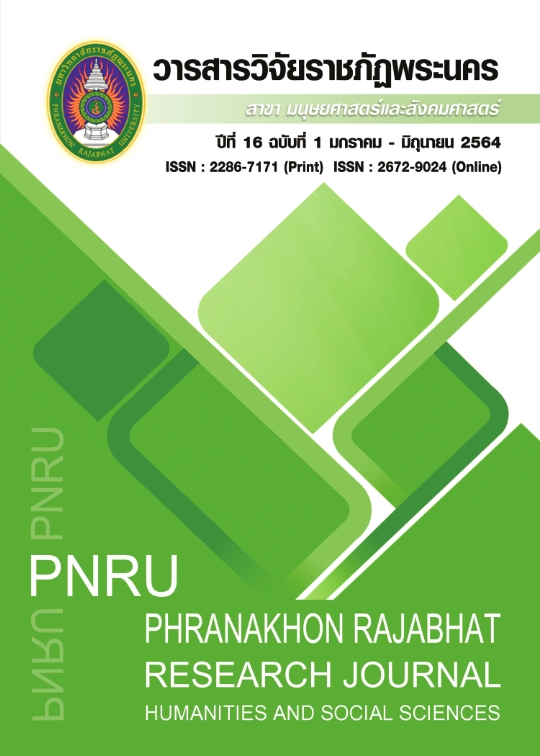STRATEGIES USED IN VOCABULARY LEARNING OF UNIVERSITY STUDENTS
Main Article Content
Abstract
The purpose of this study was to find out the vocabulary learning strategies (VLS) used by the first year as well as the second year English students at the department of Thai and foreign languages, Kasetsart University Chalermphrakiat Sakonnakhon Province Campus, and to compare the differences of strategies being used among them.The data were collected from 60 English students who were studying in the first and the second year in the second semester of 2016.Three instruments using in the study were questionnaire, semi-structured interview, and think-aloud method. The data from the questionnaire were analyzed by statistical procedures of percentage frequency, mean, and standard deviation, while the analysis of information from the semi-interview and think-aloud method had been done by studying participants’ opinions. According to determination strategies, it found that 96.6% of the first year students usually searched internet to check their words for accuracy, while 96.6% of the second year students usually used English- Thai dictionary for finding the meaning of the words. For social strategies, it found that 89.9% of the first year and the second year students usually asked their friends to help them for the meaning of new words. In order to remember the meaning of word in term of memory strategies, it found that 96.6% of the first year English students usually used a highlight pen to emphasize words meaning, but 89.8% of the second year students used an underline or a cycle words to help them remember meaning of new words. In the cognitive strategies, it found that 93.3% of the first year students and 89.9% of the second year students usually took a list of words in class when they wanted to understand the meaning of new words. It also found that 96.5% of the first year students usually used mobile phone to learn new vocabulary by switching language from Thai to English or English to Thai. However, 89.9% of the second year students found the meaning of English words from what they saw.
Article Details
Each publish articles were copyright by Phranakorn Rajabhat University
Any contents which appeared in each articles in the journal were authors personal opinion. It did not relate to Phranakorn Rajabhat University and other instructors in the university. Each authors would take responsibility on their articles. If there are any mistake, the authors will take responsibility themselves
References
Boonnoon, S. (2019). Vocabulary Learning Strategies Employed by Thai University Students across Four Academic Profiles, Theory and Practice in Language Studies, 9(8), 902-910.
Clarke, D. F. and I. S. P. Nation. (1980). Guessing the meanings of words from context. Strategy and techniques. 211-220.
Cunningsworth, A. & P. Ferst. (1992). Word Power. Strategies for Acquiring English Vocabulary. London: MacMillan Publishers Limited.
Dokchandra, D. (2019). Thai EFL learners' collocational competence and their perceptions of collocational difficulty. Theory and Practice in Language Studies, 9(7), 776-784.
Intaraprasert, C. (2005). A Preliminary Investigation of Vocabulary Learning Strategies Employed by EST Students. Suranaree Journal of Science and Technology.12(2),163-171.
Mingsakoon, P. (2003). A Comparative Study of Vocabulary Learning Strategies between Mattayom Suksa Six Students in Science and Arts Programmes at Hunkhapittayakom School, Chainat Province. Master of Science Thesis in Applied Linguistics, Mahidol University.
Nation, I. S. P. (1990). Teaching and Learning Vocabulary. Boston: Heinle & Heinle Publishers.
Nation, I. S. P. (2001). Learning Vocabulary in Another Language. Cambridge: Cambridge University Press.
O'Malley, J. M., A. U. Chamot, R. P. Russo, L. Kupper, & G. Stewner-Manzanares. (1985). Learning Strategy Applications with Students of English as a Second Language. TESOL. Quarterly 19, 557-584.
Oxford, R. L. (1990). Language Learning Strategies: What Every Teacher Should Know. Boston: Newbury House.
Satta-Udom, S. (2007). A Survey of Language Learning Strategies Used by First Year Students at Mahidol University: The Impact of Field of Study. Master of Arts Thesis in Applied Linguistics, Mahidol University.
Schmitt, N. (1997). Vocabulary learning strategies. In N. Schmitt and M. McCarthy (Eds.). Vocabulary: Description, Acquisition and Pedagogy. Cambridge: Cambridge University Press, 199-227.


